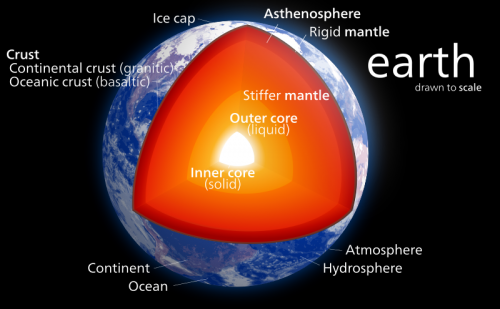May 13, 2014 report
Researchers offer 'proof' that oxygen is the only light element in the Earth's core

(Phys.org) —A trio of planetary scientists from France, Switzerland and the U.K. has used seismic data, lab experiment results and theoretical calculations as a means to offer proof that oxygen is present in the Earth's outer core. In their paper published in Proceedings of the National Academy of Sciences, the team describes how they used experimentation in the lab to exclude all other light elements existing in the outer core, leaving oxygen as the sole remainder.
Scientists have believed that the Earth's core is made up mainly of iron—subsequent analysis of seismic data readings after earthquakes, volcano eruptions, etc. along with measurements of the Earth's moment of inertia, and the composition of meteorites, has led most to agree that mixed in with the iron is a small amount of nickel. But as the core meets with the mantle, other elements creep in, some of which scientists have suspected are light elements, such as carbon, silicon, sulfur and oxygen. Seismic data alone has not been able to reveal which of them might be present, though many have suspected that the most likely is oxygen.
To "prove" which element is present, the researchers simulated conditions in the Earth's core (adding heat and pressure to a piece of iron and nickel) in their lab and then added suspected light elements. One by one they eliminated (using density functional theory) all the light elements they tested until settling on oxygen as the sole survivor. Their calculations suggest it makes up 3.7 percent of the outer core. Their testing also indicated that the outer core is also 1.9 percent silicon and that there is no carbon or sulfur.
The researchers acknowledge that their ideas regarding oxygen in the core are not new, and instead suggest their work serves as more of a proof of what has been previously suspected. What they've done, they say, is constrain the number of possible elements and the likely conditions under which the Earth's core was and is different from the mantle.
Oxygen as an ingredient in the core would suggest a warmer early Earth than has been previously theorized, the team notes, one with an oxygen rich magma ocean. More work will have to be done, though, as not all scientists will agree with the results, especially the lack of sulfur, an element present in most meteorites and suspected to make up a sizable portion of Mar's core.
More information: A seismologically consistent compositional model of Earth's core, James Badro, et al PNAS, DOI: 10.1073/pnas.1316708111
Abstract
Earth's core is less dense than iron, and therefore it must contain "light elements," such as S, Si, O, or C. We use ab initio molecular dynamics to calculate the density and bulk sound velocity in liquid metal alloys at the pressure and temperature conditions of Earth's outer core. We compare the velocity and density for any composition in the (Fe–Ni, C, O, Si, S) system to radial seismological models and find a range of compositional models that fit the seismological data. We find no oxygen-free composition that fits the seismological data, and therefore our results indicate that oxygen is always required in the outer core. An oxygen-rich core is a strong indication of high-pressure and high-temperature conditions of core differentiation in a deep magma ocean with an FeO concentration (oxygen fugacity) higher than that of the present-day mantle.
Journal information: Proceedings of the National Academy of Sciences
© 2014 Phys.org












.jpg)







